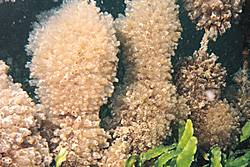Where the Dominoes Fall
The classification for the Mangrove Tunicate is as follows:
 Domain: Eukarya
Domain: Eukarya
Supergroup: Unikonta
Kingdom: Animalia
Phylum: Chordata
Class: Ascidiacea
Order: Phlebobranchia
Family: Perophoridae
Genus:
Ecteinascidia
Species: Ecteinascidia turbinata
Changes in Classification
For a long time all living organisms belonged to 5 different kingdoms including: Plantae, Animalia, Fungi, Protista, and Monera. Over time scientists discovered that this no longer fit the diversity of organisms. It was decided to split the group Monera which contained all prokaryotes into two separate groups known as Archaebacteria and Eubacteria. With this, the six kingdom system was born. However, this system too was flawed. Eventually instead of classifying organisms into six kingdoms three domains were established two of which were prokaryotic: Archaea and Bacteria, and the final domain was reserved for all eukaryotic organisms known as Eukarya.
The structure of the domain Eukarya has changed drastically. A new level of classification, the supergroup, was added when it was determined that the organisms previously belonging to Protista did not fit well morphologically or genetically in the same group. To account for all eukaryotic organisms, the previously existing kingdoms were divided into twenty-four different kingdoms. These kingdoms each belong to one of five different supergroups.
Domain Eukarya
Mangrove tunicates belong to the domain Eukarya An organism is considered to be eukaryotic based on if its cell(s) have a membrane bound nucleus, as well as membrane bound organelles.
Supergroup Unikonta
Ecteinascidia turbinata belongs to the supergroup unikonta. The word Unikonta refers to the single flagellum or in the case of amoebozoans lacking a flagella that are possessed by its members. Within this supergroup, the mangrove tunicate belongs to the opisthokonts. The opisthokonts include nucleariids, fungi, choanoflagellates and animals. The word Opisthokont comes from the Greek opisthios kontos meaning rear or posterior pole, which refers to the flagellum at the anterior portion of the cell which is common to all opishtokonts. An example of an opisthokont is the pear shaped wolf-fart puff ball.
Kingdom Animalia
The mangrove tunicate is an animal. Though this tunicate does not look like more commonly known animals, during its embryonic stages it bears many resemblances to the embryonic stages of other animals. To be considered and animal and organisms must be multicellular, heterotrophic, and have tissues that rise from embryonic layers. Tunicates are multicellular filter feeders and possess three different types of tissues. These tissues are the endoderm, the ectoderm, and the mesoderm. Some other marine animals are the great seahorse and the great white shark.
Above: A phylogenetic tree showing the phyla and subphyla within the
kingdom Animalia. Mangrove tunicates fall withing the bilaterians and
are considered to be deuterostomes. They fall withing the phylum
Chordata and the subphylum Urochordata. This tree was recreated based on
a tree found at discoverlife.org.
Phylum Chordata
As shown above this organism belongs to the phylum chordata. Chordata
are defined by having a notochord, a hollow dorsal nerve cord,
pharyngeal slits, an endostyle, and a post anal tail. As humans, which
also happen to be chordates, it may be hard to imagine having pharyngeal
slits. It is during the embryonic stage that humans possess this
feature. To be considered a chordate the organism must only possess
these features at some point in their life cycle. The tunicates possess
these features in the beginning of their life cycle and lose many of
them as sessile adults. Another chordate is this interesting fish, the
reef stonefish.
Tunicates, more affectionately known as sea squirts, are among the
subphylum urochordata. Urochordates are filter feeders which take in
water from an incurrent siphon and release if with an excurrent siphon.
Class Ascidiacea
This organism belongs to the class Ascidiacea. Ascidiacea are differentiated from other urochordates by the presence of a polysaccharide, a sugar, known as tunicin. Tunicin makes a tough outer tunic and provides the organism with more rigidity compared to other urochordates.
Order Phlebobranchia
Within the class ascidiacea Ecteinascidia turbinata belongs to the order Phlebobranchia. As a phlebobranchia, mangrove tunicates lack the posterior part of the abdomen. They also exhibit longitudinal and transverse blood vessels. Members of Phlebobranchia have unpaired gonads that are located in a loop gut.
Family Perophoridae
The class perophoridae further classifies Ecteinascidia turbinata as being colonial tunicates rather than solitary. Replication of perophoridae rises from ectodermal tissue rather than mesodermal tissue.
Genus Ecteinascidia
Members of the genus Ecteinascidia are characterized by living in tropical marine environments as well as having a vertical tail during the tadpole stage of its life.
Species Ecteinascidia turbinata
Finally the organism Ecteinascidia turbinata is distinguished by its orange pigmentation.
A phylogenetic tree extending from the Urochordates created with information from the University of Michigan's Museum of Zoology Animal diversity Website.
Continue the fun by learning about this tunicate's Habitat.